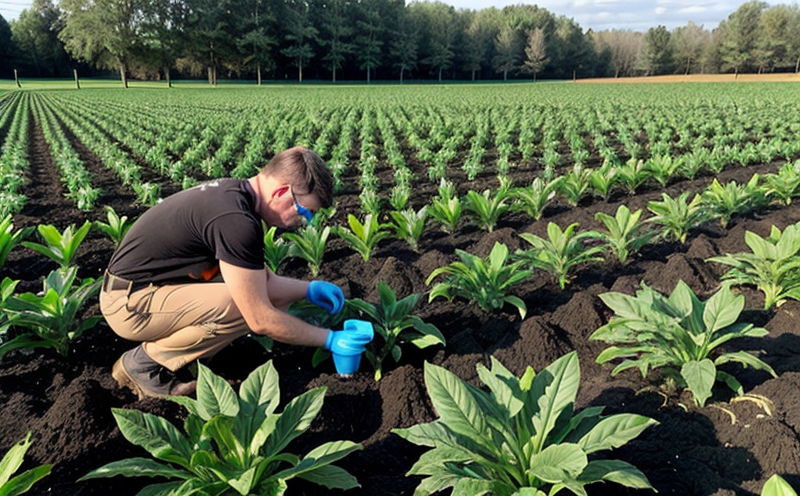Fertilizer Shelf Life Testing
In agriculture and forestry, fertilizers play a critical role in ensuring optimal plant growth and yield. The shelf life of these products is crucial as it ensures that farmers receive the expected performance from their purchases, minimizing waste and maximizing efficiency. Shelf life testing for fertilizers involves a series of laboratory procedures designed to assess how long a fertilizer remains effective under various storage conditions.
The primary focus of this testing is on nutrient retention and chemical stability over time. This includes monitoring key components such as nitrogen (N), phosphorus (P), potassium (K), sulfur (S), calcium (Ca), magnesium (Mg), iron (Fe), and other micronutrients like zinc, manganese, copper, and boron. The testing process aims to determine the point at which these nutrients begin to degrade or become less available for plant uptake.
For nitrogen-based fertilizers, such as urea or ammonium nitrate, ammonia loss is a critical parameter that must be monitored closely. Ammonia volatilization can occur due to high humidity and temperature conditions during storage, leading to significant nutrient loss. Phosphorus compounds like monoammonium phosphate (MAP) or diammonium phosphate (DAP) are also prone to hydrolysis under certain conditions, which affects their availability over time.
Testing methodologies typically involve exposing fertilizers to controlled environmental conditions that mimic real-world storage scenarios. This might include varying temperature ranges from sub-zero temperatures during winter to high summer temperatures. Relative humidity and exposure to light can also be adjusted to simulate different storage environments. Specimens are then analyzed at regular intervals to measure changes in nutrient content using analytical techniques such as atomic absorption spectrophotometry (AAS), inductively coupled plasma optical emission spectrometry (ICP-OES), or gas chromatography mass spectrometry (GC-MS).
The results of these tests provide valuable insights into the expected shelf life of fertilizers, helping manufacturers and suppliers to set realistic expiration dates. This not only protects consumers but also helps in maintaining compliance with regulatory standards such as ISO 13594 for phosphorus compounds or ASTM D2678 for nitrogen analysis.
Understanding the shelf life is essential for effective inventory management and planning, ensuring that farmers receive high-quality products when needed. It also aids in identifying potential issues early on, allowing for corrective actions to be taken before significant losses occur. This proactive approach enhances both operational efficiency and sustainability within agricultural practices.
Benefits
Ensures product quality and consistency throughout the shelf life period.
Aids in meeting regulatory requirements for labeling expiration dates accurately.
Reduces waste by preventing overuse of expired products.
Enhances customer satisfaction through reliable performance of purchased fertilizers.
Supports sustainable agricultural practices by optimizing resource use.
Improves operational efficiency in inventory management and planning.
Quality and Reliability Assurance
The testing process for shelf life ensures that each batch of fertilizer meets the desired quality standards. By closely monitoring nutrient retention, chemical stability, and potential degradation over time, laboratories can provide assurance to manufacturers and suppliers about the reliability of their products. This not only builds trust with customers but also helps in maintaining a consistent supply chain.
Quality assurance is achieved through rigorous testing protocols that follow international standards such as ISO 13594 and ASTM D2678. These standards provide a framework for conducting tests in a standardized manner, ensuring consistency across different batches of fertilizers. The use of advanced analytical techniques ensures precise measurements, reducing the margin of error.
Reliability assurance comes from the ability to predict how long a fertilizer will remain effective under various storage conditions. This information is crucial for maintaining consistent performance and minimizing unexpected variations in crop yields due to changes in fertilizer composition over time. By adhering strictly to these standards during testing, laboratories can provide reliable data that supports informed decision-making processes within the industry.
Competitive Advantage and Market Impact
In a competitive market where quality is paramount, shelf life testing offers significant advantages for manufacturers and suppliers. By accurately determining the shelf life of fertilizers, companies can position themselves as leaders in product reliability and customer satisfaction. This not only enhances brand reputation but also fosters long-term relationships with customers.
The ability to provide accurate expiration dates based on reliable shelf life data sets a benchmark that competitors find challenging to match. It demonstrates a commitment to excellence in product quality, which is increasingly valued by discerning consumers who demand high standards of performance from their suppliers.
In terms of market impact, knowing the shelf life helps in optimizing inventory management and reducing waste. This translates into cost savings for businesses while also benefiting the environment by minimizing resource depletion associated with unnecessary production runs or overstocking. For procurement departments within companies involved in agricultural inputs, having access to this information allows them to make informed decisions that balance supply chain efficiency with environmental responsibility.
Moreover, compliance with regulatory standards like ISO 13594 and ASTM D2678 ensures that products meet industry expectations while avoiding potential legal issues related to non-compliance. This level of adherence not only protects companies from liability but also strengthens their position in the marketplace as trusted partners capable of delivering consistent performance across all product lines.





